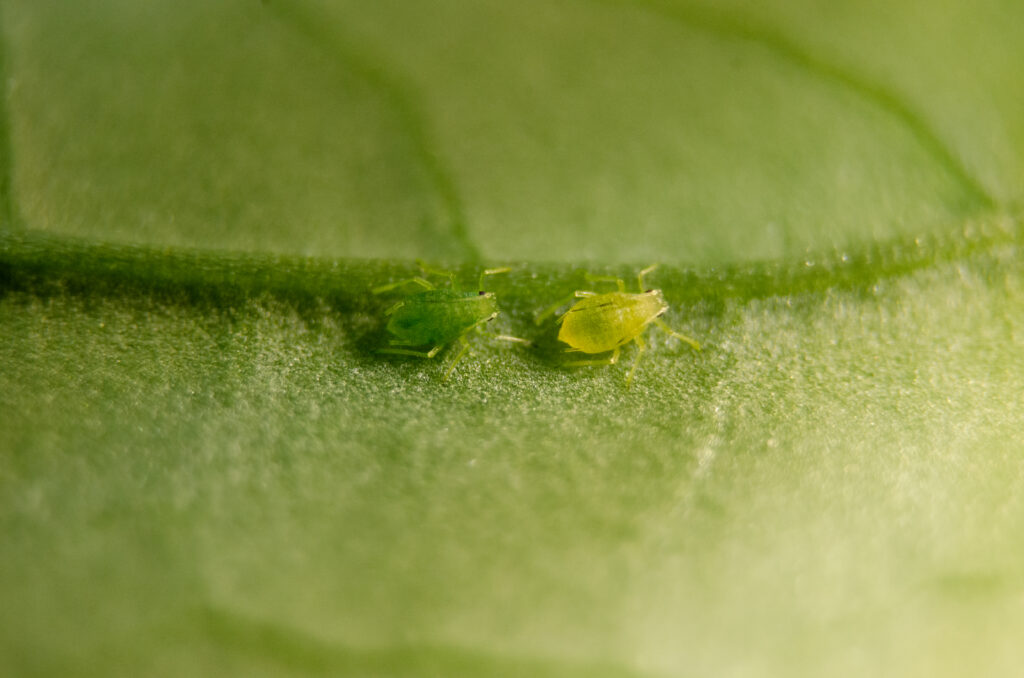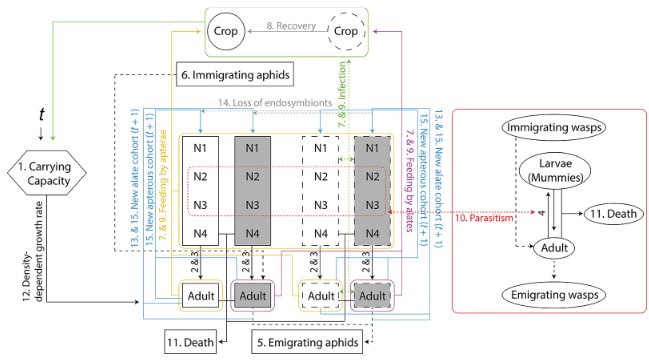Aphids are a common headache for growers, particularly in broadacre crops like canola.
Traditional methods of control have relied heavily on chemical pesticides, but as aphids increasingly evolve resistance, these are becoming less effective.
What if there was an alternative? A more natural way to control aphid populations? Enter Rickettsiella, a bacterial endosymbiont that could change the game in pest control.
What are endosymbionts?
Endosymbionts are bacteria that live inside insects, often forming beneficials partnerships.
Endosymbionts can help insects digest food, tolerate extreme temperatures, or even protect them from predators. In exchange, the bacteria get a safe place to live and a steady food supply from their insect hosts.
But not all endosymbionts are purely helpful. Some come with a few downsides for their insect hosts.
For farmers, this is where things get interesting. Researchers are exploring how these bacteria might be used to weaken pest insects, potentially becoming a tool in pest management.
Turning aphids against themselves: how endosymbionts could suppress pest populations
As part of the Australian Grains Pest Innovation project supported by the GRDC and HortInnovation, researchers at the University of Melbourne, Pest and Environmental Adaptation Group, and Cesar Australia are exploring the possibilities of transferring endosymbionts between aphid species through microinjections. By introducing these microbes into new aphid hosts, researchers can explore how these unique partnerships affect the aphids’ survival, potentially opening up new possibilities for pest control.
One of these endosymbionts, Rickettsiella viridis, exists naturally in two aphid species in Australia, the pea aphid (Acyrthosiphon pisum) and the corn aphid (Rhopalosiphum maidis). In the pea aphid, Rickettsiella may provide conditional benefits, like increased survival after fungal infections.
However, when researchers transferred Rickettsiella into green peach aphids, a novel host, they found the relationship is a lot less friendly. In fact, it drastically reduces the ability of green peach aphid to reproduce—infected females produce only about half as many offspring as their uninfected counterparts.

From plant to pest: transmission dynamics of Rickettsiella
In laboratory populations, the spread of the endosymbiont between green peach aphids was expected to be limited due to the reduced reproduction rate, and this might prevent the infection from spreading effectively and cause it to eventually disappear from the population.
However, Rickettsiella was shown to spread through aphid populations in two different ways; via their offspring (vertical transmission) and via the plants they feed on (horizontal transmission).
This was an important finding, as the success of Rickettsiella as a pest control agent heavily depends on this horizontal transmission rate.
In a field based setting, if the endosymbiont spreads effectively between aphids through infected plants, it can still dominate the population despite individually infected aphids reproducing more slowly, thus potentially suppressing aphid populations.
However, if the rate of transmission through infected plants is too low, the infection won’t spread fast enough to compensate for the reduced reproductive output of infected aphids, leading to a situation where the infection disappears from the population before it has a chance to control aphid numbers.
Lab to landscape: modelling Rickettsiella’s real-world impact
Endosymbionts like Rickettsiella offer a new approach to pest control, but translating this potential into effective field strategies is complex. Success depends on factors like its spread between aphids, environmental influences, and interactions with other pests and beneficial insects in real-world farming conditions.
That’s where computer modelling steps in.
Researchers have developed a model that, although it looks complicated, essentially simulates Rickettsiella spread through aphid populations in various agricultural regions across Australia, using real-world climate data.

The model considers several key factors:
- Temperature: Green peach aphid reproductive rate and Ricketsiella transmission efficiency peak at slightly different temperatures, and the model helps identify when and where it could be most effective.
- Reproduction rates: Infected aphids reproduce at roughly half the rate of uninfected ones.
- Horizontal transmission: The model simulates how effectively the endosymbiont moves between aphids through the plants they feed on, the key for its success as a pest control method.
By considering these three factors, the model helps identify under which environmental conditions horizontal transmission of Rickettsiella is fast enough to compensate for the reduced reproduction of infected aphids and lead to a decrease in aphid numbers.
The model predicts that under the right conditions, Rickettsiella could spread through aphid populations and significantly reduce their numbers. For example, in regions like Albany and Geraldton, the model suggests Rickettsiella could reduce aphid populations by up to 70%.
Timing, scale, and the road to field success
The implications of this research are exciting for farmers. Modelling suggests Rickettsiella could effectively reduce aphid populations, especially in cooler and drier climates.
However, whilst Rickettsiella might spread naturally once released due to horizontal transmission, the research also highlighted that the timing and scale of releases matter. Larger releases of infected aphids are more likely to lead to significant population suppression and introducing them shortly after crop emergence, while conditions are still favourable for transmission and before uninfected aphid populations have had a chance to fully establish, increases their chances of success.
That said, applying Rickettsiella in the field comes with some challenges. The models are based on controlled conditions and assume a closed system—they don’t account for real-world variables like aphid migration between fields or environmental factors like the presence of other pests or natural predators.
For these reasons, field trials will be essential to validate these findings and fine-tune the approach to ensure it delivers reliable, long-term pest control without unintended consequences.
Ongoing research under the Australian Grains & Horticulture Pest Innovation Program (AGHPIP) will provide further insights into the potential role of Rickettsiella in future sustainable pest management strategies, making this an exciting space to watch!
More information
Endosymbionts: Game changing bacteria in insect species
The role of aphids and endosymbionts in revolutionising pest management in Australia
Acknowledgement
To read more about the research undertaken, you can find the paper here.
This research is being undertaken as part of the Australian Grains and Horticulture Pest Innovation Program (AGHPIP). AGHPIP is a collaboration between the Pest & Environmental Adaptation Research Group at the University of Melbourne and Cesar Australia. The program is a co-investment by the Grains Research and Development Corporation (GRDC), Hort Innovation, and the University of Melbourne, together with in-kind contributions from all program partners.
Thanks to Alex Slavenko (Cesar) and Alex Gill (PEARG) for technical reviews.
Cover image: Photo by Lilia Jenkins, Cesar Australia.
